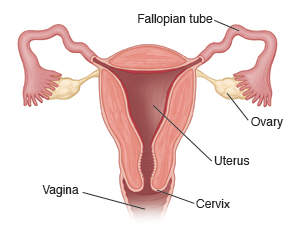Endometriosis

Endometriosis is a condition that occurs when the tissue that lines the uterus starts to grow where it should not. The tissue may grow on the outside surface of the uterus, the ovaries, or fallopian tubes. It may also grow on the bowel, rectum, bladder, or other areas. The tissue responds to the same hormones that control your menstrual cycle. So it may swell and bleed just like the lining of the uterus, which is shed every month during your period. The swelling and blood irritate nearby tissues. This causes pelvic or lower belly (abdominal) pain and cramping. The pain is often worse around the time of your period. Pain during sex is also common. Some people have pain during bowel movements or urination. Over time, scar tissue may form. This scar tissue can bind organs together. It can also cause problems getting pregnant (infertility).
The exact cause of endometriosis is unknown. The best way to confirm a diagnosis is with a procedure called laparoscopy. This allows the healthcare provider to look inside the abdomen with a small tube and light.
Treatment depends on your symptoms. If pain is mild, you may not need treatment. If pain is more severe, medicines may be advised. Surgery may also be a choice. Your provider can tell you more as needed.
Home care
Medicines
To help manage endometriosis, any of the following medicines may be used:
If you’re prescribed medicines, take them as directed. Also report any side effects you have to your provider.
General care
-
Rest as needed when you have symptoms.
-
To help ease pain or cramping, apply a heating pad to where the pain is. You may also use a hot water bottle.
Follow-up care
Follow up with your healthcare provider, or as directed.
When to get medical advice
Call your healthcare provider right away if any of the following occur:
-
Fever of 100.4°F (38°C) or higher, or as directed by your healthcare provider
-
Abdominal or pelvic pain or cramping gets worse, or doesn’t get better with medicines
-
Pain during sex, urination, or bowel movements continues
-
Heavy bleeding (soaking 1 pad or tampon every hour for 3 hours)
-
Missed periods (if they are usually regular)
-
Sudden, severe pain in the abdomen
-
Abdominal swelling with nausea or vomiting
-
Blood in the urine or problems urinating
-
Blood in the stool
-
Dizziness, weakness, fainting
Infertility
Note: If you have been unable to get pregnant after trying for 1 year, see your healthcare provider. They can talk with you about infertility testing.